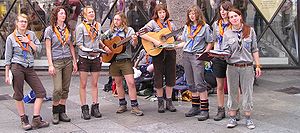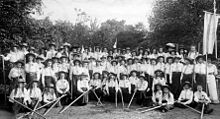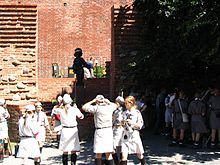
Girl Guiding and Girl Scouting
About this schools Wikipedia selection
This content from Wikipedia has been selected by SOS Children for suitability in schools around the world. A good way to help other children is by sponsoring a child
A Guide, Girl Guide or Girl Scout is a member of a section of some Guiding organisations who is between the ages of 10 and 14. Age limits are different in each organisation. The term Girl Scout is used in the United States and several East Asian countries. The two terms are used synonymously within this article.
Girl Guides are organised into units/troops averaging 15-30 girls under guidance of a team of leaders. Units subdivide into patrols of about six Guides and engage in outdoor and special interest activities. Units may affiliate with national and international organisations. Some units, especially in Europe, have been co-educational since the 1970s, allowing boys and girls to work together as Scouts. There are other programme sections for older and younger girls.
Naming
Robert Baden-Powell was a famous soldier who fought in the Boer War in South Africa at the beginning of the 20th century. During the Siege of Mafeking, when the town and British soldiers were besieged by Boer soldiers, B-P noticed how the young boys made themselves useful by carrying messages for the soldiers. When he came home, he decided to put some of his Scouting ideas into practice to see if they would be any good for young boys and took 21 boys camping on Brownsea Island, near Poole in Dorset. The camp was a success, and B-P wrote his book Scouting for Boys, covering tracking, signaling, cooking etc. Soon boys began to organize themselves into Patrols and Troops and called themselves "Boy Scouts". Girls bought the book as well and formed themselves into Patrols of Girl Scouts.
In 1909 there was a Boy Scout Rally at Crystal Palace in London. Among all the thousands of Boy Scouts there was also a group of girls from Pinkneys Green, in Berkshire, who spoke to B-P and asked him to let girls be Scouts. B-P decided to take action.
In those days, for girls to camp and hike was not common, as this extract from the Scout newspaper shows: "If a girl is not allowed to run, or even hurry, to swim, ride a bike, or raise her arms above her head, how can she become a Scout?"
B-P's career had been in the British Army. There was an Indian regiment called the Khyber Guides who served on the north-west frontier of India. B-P persuaded the girl "Scouts" that Guides was a very special name of which they could be proud. So, in 1910 the first Girl Guides began.
Since 1910 Guides have spread and there are now millions of Guides worldwide. The World Association of Girl Guides and Girl Scouts (WAGGGS) was formed to link together Guides. In some countries the girls preferred to call themselves ‘Girl Scouts’.
(Reference: 'The Guide Handbook', London: The Guide Association, 1996)
The first Guide Company was 1st Pinkneys Green Guides (Miss Baden Powell's Own), who still exist in Pinkneys Green, Maidenhead in the English county of Berkshire.
Key points
Things that are shared amongst all Guide Units are:
- The Guide Promise - Girls become Guides by making their Promise. Each country has its own Promise but all have the same 3 parts: duty to God or to your religion; duty to your country; keeping the Guide Law.
- The Good Turn - each Guide tries to do a kind thing for someone else, without payment and without being asked, every day.
- The World Badge - this can be worn on uniform or ordinary clothes. The three leaves of the trefoil stand for the threefold Promise. The vein in the centre is a compass needle, pointing the way and the two stars stand for the Promise and the Law. The colours stand for the golden sun shining over all the children of the world, from a blue sky. This badge is a guiding symbol that can be recognized all over the world.
- The World Flag - this is in the same colours as the World Badge and can be carried or flown by any member of the movement. It is often used as the Unit Flag. The three yellow blocks represent the threefold Promise and the white corner represents the commitment to peace of all WAGGGs' members.
- The Guide Sign - the three fingers stand for the three parts of the Promise. The Guide sign is used when making or renewing the Promise and can be used when meeting other Guides. It may also be used when receiving a badge or at the end of meetings.
- The Motto - Be Prepared - This means that Guides are ready to cope with anything that might come their way.
- The left handshake - this is the way members of the Movement greet each other. The left hand is the one nearest the heart and so shows friendship. Also, warriors held their shield in their left hand, so by putting down your shield, it meant that you were vulnerable, making it a display of both bravery and trust.
- Thinking Day - on the 22 February each year Guides think of their Guide sisters all around the world. The date was chosen at a World Conference because it was the birthday of both the Founder and the World Chief Guide.
- The World Centres - there are 4 Guide homes in different parts of the world: Our Chalet in Switzerland; Pax Lodge in London; Our Cabana in Mexico; and Sangam in India.
- The World Chief Guide - Olave, Lady Baden-Powell is the only person ever to have been World Chief Guide. She was the wife of the Founder, Lord Baden-Powell of Gilwell and lived from 1889 to 1977.
Unit affiliation
Local groups, called variously units, companies or troops are the fundamental unit of the Girl Guides. These are run by an adult, normally a woman who is between 18 and 65 years of age. She has responsibility for the girls in her group and plans out activities for the girls as well as leading the meetings. These leaders are supported by assistants. Meetings are held anywhere from weekly to monthly depending on the commitments of the participants and the activities in progress.
Uniforms
Individual national or other emblems may be found on the individual country's Scouting article.
Uniform is a specific characteristic of Scouting. Robert Baden-Powell said it "hides all differences of social standing in a country and makes for equality; but, more important still, it covers differences of country and race and creed, and makes all feel that they are members with one another of the one great brotherhood".
In the 1909 The Scheme for Girl Guides, the uniform for the newly emerging movement was given as:
Jersey of company colour. Neckerchief of company colour. Skirt, knickers, stockings, dark blue. Cap - red biretta, or in summer, large straw hat. Haversack, cooking billy, lanyard and knife, walking stick or light staff. Cape, hooked up on the back. Shoulder knot, of the 'Group' colour on the left shoulder. Badges, much the same as the Boy Scouts. Officers wear ordinary country walking-dress, with biretta of dark blue, white shoulder knot, walking stick, and whistle on lanyard.
Guide uniform varies within cultures, climates and the activities undertaken. They are often adorned with badges indicating a Guide's achievements and responsibilities. In some places, uniforms are manufactured and distributed by approved companies and the local Guiding organization. In other places, members make uniforms themselves.
Lones
Lones are girls who live too far away to attend meetings in a guide district. Often they run the program by mail, but there are some girls who are part of Lones of the Air who talk and have unit meetings by radio. Lones have an 'L' on their promise badge.




